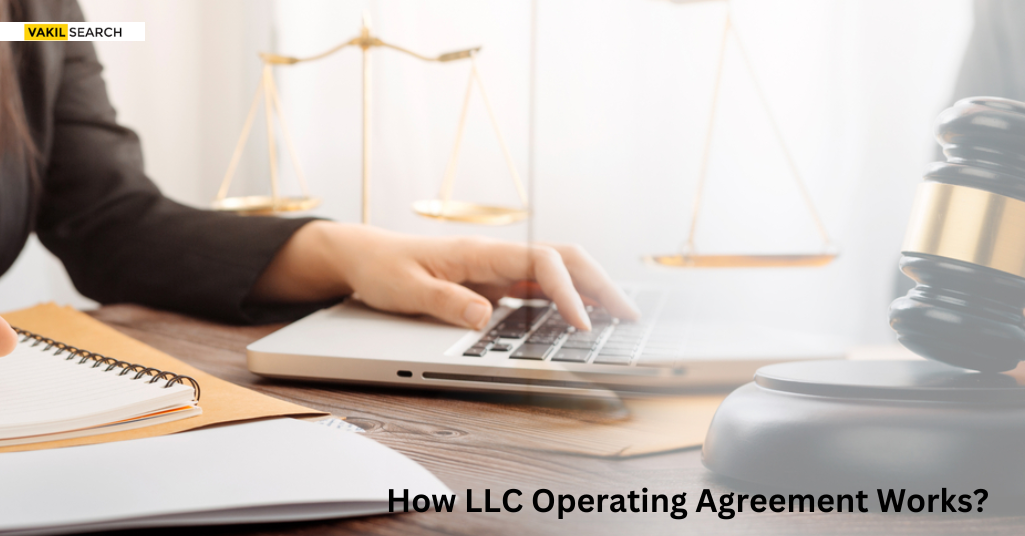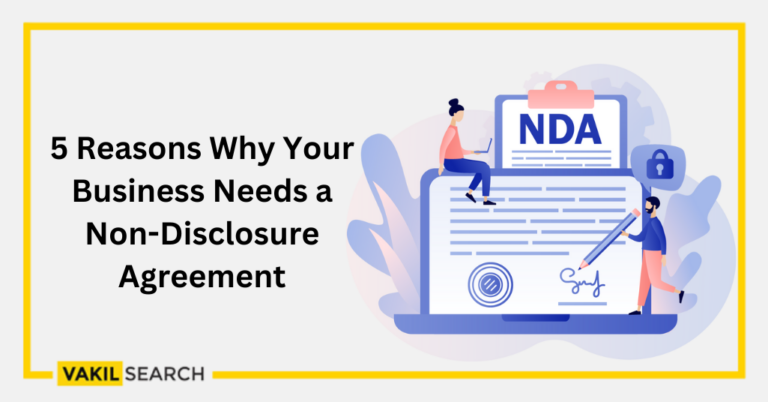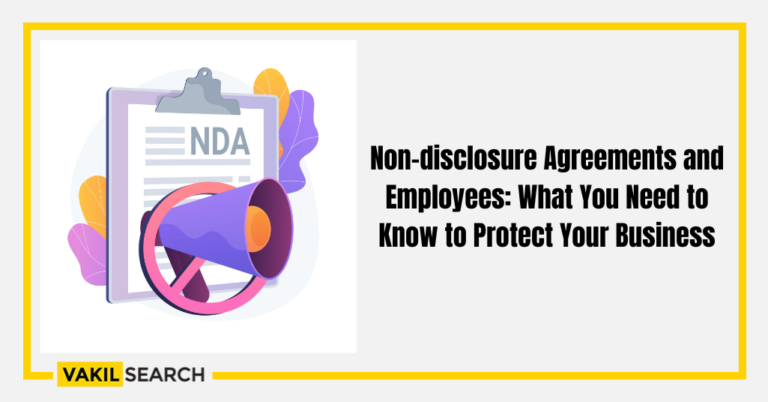In this article, you will learn about the concept of a Non-Disclosure Agreement (NDA) and why NDA is required.
A Non-Disclosure Agreement, likewise by and large called a ‘Secrecy Agreement’, is an understanding wherein the concerned parties consent to share the classified data/information which is determined in the ‘Privacy Clause’ of the Non-Disclosure Agreement.
The gatherings to the Non-Disclosure Agreement likewise make a deal to avoid uncovering such data to the outsider past the particulars of the arrangement.
Different Names of the Non-Disclosure Agreement :
A Non Disclosure Agreement has different names like:
- Confidential Agreement (CA)
- Confidential Disclosure Agreement (CDA)
- Secrecy Agreement (SA)
- Proprietary Information Agreement (PIA)
- Master Service Agreement Online
What are the Benefits of Entering a Non-Disclosure Agreement?
Nowadays, be it a Startup or other companies, the significant resource of any corporate body is its Intellectual Property. A Non Disclosure Agreement helps safeguard the gatherings’ Intellectual Property Rights, including its data sets, client records, restrictive data, sensitive business-related data, and so on.
Following are a few significant advantages of going into an NDA –
- The Confidentiality Clause in the Non-Disclosure Agreement obviously characterises the ‘secret matter’ upon which the Non-Disclosure Agreement is placed.
- It helps keep up with the most significant secrecy between the gatherings by restricting them legitimately through different provisions under the Non Disclosure understanding. This precludes the getting party from revealing the private data.
- Different conditions of the Non-Disclosure Agreement likewise draw the timetable up to which the party is obliged to keep up with the confidentiality. This period could be past the viable time of the NDA itself.
- Non Disclosure Agreement is legitimately restricting. Accordingly, the party infringing the arrangement would be lawfully responsible for reimbursing the harms to the distressed party (which is generally the uncovering party).
- The debate can be alluded to by the Arbitrator or even taken to court if the degree of infringement is requested. That is how the proprietors of the classified data are conceded help as they have required work to shield the common secret data through the Non-Disclosure Agreement.
You can know about the Online NDA Format from all our experts.
Under Which Circumstances Should an NDA be Signed?
There are different occasions or conditions under which you can use a Non-disclosure Agreement/ NDA. They are as follows:
- Into an agreement;
- While taking a master’s recommendation on another item;
- While beginning another venture;
- While researching a chance to venture with another party;
- While giving employment;
- While marking a contractor for a sensitive undertaking;
- While managing touchy client data;
- While talking about industrially touchy data with other parties and so on.
To keep it got according to the provisions of the Non-Disclosure Agreement, which are embedded to shield the restrictive data from being misused.
What is the Essential Content Included in the NDA?
Meaning of Confidential Information:
What is ‘Confidential Information in the exchange between the gatherings will be obviously covered under the non-exposure understanding. The revealing party could have a more extensive definition since this party typically gets more substantial advantages under this understanding. Though, the receiving party might have a minor purpose for the equivalent.
Non-Confidential Information
Embedding a statement referencing what is definitely not Confidential data is similarly significant. There could be numerous exchanges for which some data can’t be anticipated to stay classified. Likewise, the data now accessible to the public can’t be treated as ‘Confidential Information.
Term of Confidentiality
Any Non Disclosure Agreement should characterize and present the time frame of the existence of the NDA. Contingent on the idea of the exchange covered by the arrangement, the existence of the non-revelation understanding can be chosen. It very well maybe one year, ten years or for endless time.
Exposure
The Non-Disclosure Agreement will likewise characterize with whom the party is permitted to share the classified data. Particularly while leading a reasonable level of investment or breaking down the party’s idea, the other party might have to share a few classified information (like monetary information) with its related agents, accomplices, or organizations. The ‘revelation’ component will likewise be plainly indicated along these lines.
Special cases for Confidentiality
There may be a few inescapable circumstances in which the party is under commitment to uncovering the secret data from the outsider. Such cases might assume that the regulatory power and government bodies might request such confidential data, or for official action, the party may be approached to unveil such private data.
In such circumstances, the party sharing such personal data will not be considered encroaching on the Non-Disclosure Agreement terms. Consequently, important exemptions for the Non-Disclosure Agreement will likewise be determined.
The most effective method to Return the Confidential Information
For the most part, the approach to taking care of personal data relies upon the idea of the common data. There will be a condition which determines in what direction and inside what time the beneficiary is supposed to either return the record or is expected to destroy the entire data got by the beneficiary as the classified data.
This is significant as the data revealed under the NDA will not stay accessible to the beneficiary after the existence of the Non-Disclosure Agreement.
Cures
The unveiling party is a more excellent gamble while sharing private data. In this manner, if any encroachment of the understanding or break of arrangement conditions happens, the cures accessible to the abused party will be referenced in the arrangement.
Association with Employees
After setting up the arrangement, the other party frequently comes in contact with the representatives of the revealing party, which could give such party an edge to captivate the unveiling party’s workers.
They might incite such representatives to pass on their ongoing work to work for them. To protect the association from losing such likely representatives, the non-exposure understanding will have a worker requesting condition confining the other party from instigating or tempting the workers.
What is a Non-Disclosure Agreement (NDA)?
Imagine you’ve developed a groundbreaking invention, formulated a unique business strategy, or created a masterpiece of art. An NDA is like a legal shield that ensures anyone you share these confidential details with cannot disclose or misuse them.
In simpler terms, an NDA is a formal agreement between you (the disclosing party) and another party (the recipient) to keep certain information confidential and not share it with others.
Non-Disclosure Agreement vs. Confidentiality Agreement
At first glance, NDAs and Confidentiality Agreements may seem like two sides of the same coin. However, they have differences.
A Confidentiality Agreement is a broader term that encompasses various agreements aimed at protecting sensitive information.
On the other hand, an NDA is a specific type of Confidentiality Agreement that focuses solely on preventing the disclosure of specific confidential information.
How to Write a Non-Disclosure Agreement
Creating an NDA might sound complex, but it’s like assembling a puzzle with the right pieces. Here’s a simple guide to crafting an effective NDA:
Parties Involved: Clearly state the names and contact details of the disclosing and recipient parties.
Definition of Confidential Information: Describe the type of information that needs to be kept confidential. Be specific to avoid ambiguity.
Purpose: Explain why the disclosing party is sharing this confidential information with the recipient. This sets the context for the agreement.
Obligations of the Recipient: Outline the recipient’s responsibilities, including the commitment not to disclose the information, the measures to protect it, and the limited purposes for which it can be used.
Term and Termination: Specify the duration of the agreement and the circumstances under which it can be terminated.
Consequences of Breach: Clearly state the consequences if either party breaches the agreement. This may include legal actions or financial compensation.
Governing Law and Jurisdiction: Define the laws that will govern the agreement and the jurisdiction where disputes will be resolved.
Understanding Non-Disclosure Agreements (NDAs)
Now that we’ve unravelled the basic components of an NDA, let’s dive deeper into their significance:
Protection: NDAs offer a shield of protection for your confidential information, preventing others from using it for their advantage.
Trust Building: By having an NDA in place, you demonstrate your commitment to safeguarding sensitive information, which fosters trust in your business relationships.
Legal Recourse: If someone breaches the NDA, you have legal grounds to take action, ensuring that your rights are upheld.
Types of Non-Disclosure Agreements
NDAs come in various forms to cater to different scenarios. Here are some common types:
Unilateral NDA: One party discloses information to another party. This is often used when a business shares its proprietary information with employees or contractors.
Bilateral NDA: Both parties exchange confidential information. This is common in partnerships or collaborations where mutual sharing is essential.
Multilateral NDA: Multiple parties exchange confidential information. This is often used in complex business deals involving multiple stakeholders.
Conclusion
In this article, we have covered the Non-disclosure agreement and its benefits, along with the contents included in the agreement. Hope this blog was helpful!
Read More:-
- Do NDAs Need to Be Notarized?
- Definition about Employment Non Disclosure Agreement
- Damages for Breach of Non Disclosure Agreement
- Key Elements of a Non-disclosure Agreement
FAQs
Why should you use a non-disclosure agreement?
An NDA is a legally binding contract that protects confidential information from being disclosed to unauthorized parties. This can be important for businesses that want to protect their trade secrets, intellectual property, or other sensitive information.
Where is the non-disclosure agreement used?
NDAs can be used in a variety of contexts, including:
1. Business negotiations
2. Hiring new employees
3. Sharing confidential information with third parties
4. Collaborating with partners
5. Outsourcing work
Who benefits from a non-disclosure agreement?
Both parties to an NDA benefit from the agreement. The disclosing party benefits by knowing that their confidential information is protected, and the receiving party benefits by being able to access the confidential information without fear of legal repercussions.
What are the 2 types of non-disclosure agreement?
There are two main types of NDAs: unilateral NDAs and mutual NDAs.
Are NDAs valid in India?
Yes, NDAs are valid in India. They are considered to be legally binding contracts, and they can be enforced by the courts.
How long is the NDA valid for?
The length of time an NDA is valid for will be specified in the agreement. However, in general, NDAs are valid for a period of 3 to 5 years.
What is the advantage of non-disclosure?
The advantage of non-disclosure is that it protects confidential information from being disclosed to unauthorized parties. This can help to protect businesses from losing their competitive advantage, and it can also help to protect individuals from having their personal information misused.










